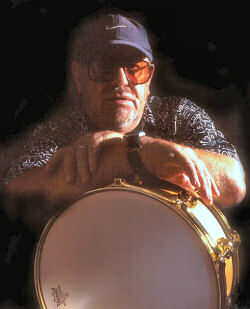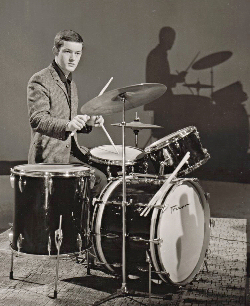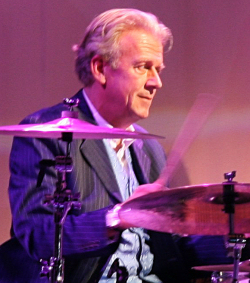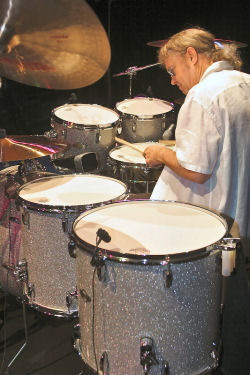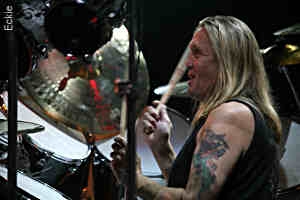
The Mighty Nicko McBrain
Early in 1981, a youthful and acned Mike Ellis arrived at a north Wales venue to be greeted by a monstrous Sonor kit already set up on stage and realised his diminutive Ludwig 4 piece Super Classic was going to be convincingly dwarfed during the opening set.
After setting up, I experienced the whirlwind that was (and still is!), Nicko McBrain. After enthusing about my kit, he gave me a guided tour of his drumming kingdom and showed off a new cymbal he just got, one of the first Paiste RUDEs.
Since then, we’ve both got a bit older, but he hasn’t lost any of his enthusiasm for playing, for drums and for talking about drums. After introducing myself, he said “’Ere, don’t I know you from somewhere?” I told him when we last met and agreed, he must have been thinking of someone else – lest I get ideas above my station in the ‘making a lasting impression on someone’!
As our last meeting way back when started on the subject of cymbals, I thought I’d start by revisiting the subject.
ME: Paiste went through a big revamp of their branding some years ago and have just reinstated the 2002 range as their core line; did any of those changes affect your choices?
NMB: They were going through a lot different family names, adding various bits and bobs. Eric Paiste was lovely, we were in LA together, doing some promo pictures for Paiste, great shots, black and white, behind a black kit, with a glass of red wine in my hand and Eric says to me; “Nick, we’ve got our 20th anniversary for the 2002 series coming up, would you consider using just 2002 cymbals?” So I said “Yes, but there’s only one problem with that, to be honest I don’t think you have a suitable ride for me in the 2002 series.” I told him that I was used to using a Sound Creation Power Bell Ride. 22”, big bell, they don’t come like that in the 2002.
He said, “Well, we’ll make you one!” So, I got together with Michael Paiste, at that time he was in sound development and we did it over the phone. He made a bunch of prototypes and every time one was finished, he’d phone me and I remember it was so wonderful when the cymbal was done. It’s an absolute gem, it really is, classic 2002, power, cut, the bell is just stunning. So I used 2002s up to the Dimensions and when I went with the Dimensions I started using the 22” Power Bell Ride from that series, that’s the cymbal that’s used on ‘Rock in Rio’. But I’ve come back now to the Signature line and for the last tour they did a reflected series in the Signatures, which looks stunning, but it took a little top end of them which sometimes works, sometimes it takes a little brightness out which I’m used to as use all Power Crashes except for a 17” RUDE on the right. They made me a 15” RUDE power crash on the left of the kit, it’s sounded great but when you’re playing with the band, you can’t hear it when you hit it! It just disappears at the back!
ME: I find sometimes drummers don’t always choose the right cymbal for the job. I’ve had some interesting conversations with drummers about RUDEs and applications, from the drummer’s position, other players tell me they’re too big, dark, not very sweet…
NMB: Yeah but you go over there, out in the hall.
ME: The entire top end comes out, over the music, right to the back.
NMB: That’s right. We just got together yesterday for rehearsals for today’s soiree and I’ve got a Premier Artist Maple kit, a small kit, 24, 18 floor tom and 12 and 13 tom on the bass drum so if I play a five piece, that is it and it records fantastically well this drum kit. I’ve got a 20” RUDE crash ride as the ride which is strange for me as I’m used to a 22” for a ride cymbal and that 2” don’t half make a difference when you hit it! I also have an 18” and 16” Power Crash cymbals and regular 2002 Sound Edge hi hats.
ME: Interesting mix! When we last met all those years ago, I’d just done some recordings and had my first 2002 crash and I’ve found that all these years later, I’ve still stuck with 2002s despite all the new lines that have been issued since.
NMB: It’s very personal with drummers, most drummers anyway, when they find something exciting sound wise, and they tend to stick with that. I’ve been with Paiste forever, since I was a kid, the first cymbal I ever bought was Formula 602 18” crash. Then I bought an 18” Zildjian Heavy Band and it like a ride crash, kind of like a RUDE, you could ride it, crash it, but then the bloody thing fell off the bell! So then I went into a deal with Paiste via Mark Goodwin at The Soundhouse on Tottenham Court Road. I went to see John Hill at Arbiters with all my cymbals and he said; “What have we got here then?” And I said “What do you think it is? It’s a bunch of cracked cymbals!!” So he says to me; “You must be playing them wrong if you’re cracking them like that.” So, we had this ‘bad’ set off, it wasn’t the best start.
I asked if he’d come down to a rehearsal, I’d just joined ‘Trust’ and had the whole bunch of cracked cymbals so he came to a rehearsal and I used to play everyone of my cymbals like Buddy Rich – dead flat, but high. First thing he said was; “See, I told you you’re playing them wrong!” So asked me if knew happens when you hit that cymbal at a 90 degree angle, I told him, “They sound ****ing great!” He explained that the stroke goes through the cymbal and back out, you want it to ‘ride around’ the cymbal, angle them a little bit and you won’t crack as many. From that day on, my cracked cymbals went down by about 75%. You can have your cymbals flat, but so long as the stroke comes in from the top side, the cymbal has to ‘flow’, a lot of people who do hit hard, have the cymbal tightened up too much. You’ve got to have what’s known in aviation as ‘full and free movement’, if it’s too screwed down you’ll full movement when you whack it, but with all those felts holding it in place, it won’t be free.
I don’t hit them as hard as I used to, I’ve got a different technique now. I could drive Iron Maiden now doing it the old way I used to play; stick back here (raises hand over his head), that drum drumhead is in my way of this stick going to floor! It’s was all about powering through it! Normally when I do ‘wear, tear and care’ sections, I talk about how to look after your drum kit and people say; “Well it’s alright for you Nick, you get all your stuff free!” I still look after it, every drum tech I’ve had knows that. Most of them are drummers themselves, so it’s always check the plastic sleeves are in place, stop the key holing happening.
ME: I see this poor maintenance when I have to kit share, often the cymbal stands have no sleeves.
NMB: Yeah! It’s a bare piece of metal and you ask them; “How long have had it like that?! What do your cymbals look like? Oh yeah there’s a lovely keyhole there!”
ME: It’s very, very basic stuff.
NMB: It is. When you get your first drum kit, you save your money up, you buy one straight, or you go and get one on the old ‘tick-tack’ and you get it home, you’re polishing it and you’re in love with it! You finally get the kit set up and that’s it, but then there is a learning curve, not only as the art of drumming but the art of looking after the kit. Making sure the bass drum pedal’s oiled up, making sure the centre rod on the hi-hat isn’t bent and cymbal care. I’ve seen people take their cymbals and just drop them on the floor! It’s basic stuff but it is so important. I think mikedolbear.com is great for this sort of thing because you can go there and get all kinds of information and advice. All you’ve got to do is ask, a lot of kids won’t ask a guy in a music shop because some of them will just say “Oh I’m too busy I can’t talk to you right now.” How long does it take?
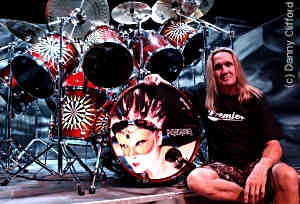
Nicko McBrain
ME: What about tuning your drums?
NMB: My top head is a smidge tighter than my bottom head. Not the other way round and I always tune the bottom head first. Having so many drums, if you start with the 14 and do what you do, you kind of know where it is but you can be out to such a degree because you’ve got so many drums. OK, 6”, 8”; 2 inch difference. 8”, 10”; 2 inch difference. 10”, 12”; 2 inch difference. Now, the fun starts; 12”, 13”, 14”, 15”, 16”; one inch in between. Now there’s not a lot of room where the drum sits comfortably to make it have its own identity yet be tonally different.
Say I take my 14” and I get it in tune, it’s actually where the 13” should be so when of course when I get up to the 6” and 8”, the 8” in fact, is tuned too high! I can’t even tighten the 6” up, that’s where it will throw you out. So what I do, is I start on the floor tom, you can’t really get that too tight, so next, 16”, 15”, 14” – go up the drums.
Now if you have gone a bit too tight you’ll know by the time you get to the 12” that you’ll have to start again. So, whereas there are people who will tune to a note, a C or a D or an E flat, some tune to songs to be tympanic, but I just do it by ear, there’s no set note, its ball park. And of course, it all depends on what type of drumheads you use. I went from using beech wood shells with Ludwig silver dots, to a maple shell which was ridiculously thick, not quite as hard, with I change I made from Sonor to Premier Maple, I had to find different drumheads. I was with Remo forever, then I went with Sonor’s drumheads, then back to Remo, then to Premier drumheads and finally back to Remo where I settled on the ambassador coated and I use the ebony series on the bottom, which is actually a top head, it’s not really designed to be used as a bottom head.
I use Remo because before I was being supported by Remo, I liked their heads and bought them anyway. My relationship with Remo is astounding because I’d left them a couple of times and when a friend suggested I got a Remo deal, I said I had a Remo deal and left and I don’t think they’d be interested in having me back! But they were so gracious, they said if you want to come back, we’d love to have you back and what do you want to use?
ME: What about staying in tune during the set?
NMB: I’ll do 4 songs in a row, because normally we go on stage and ‘bam-bam-bam-bam’, and you’ll see my drum tech come on and he will be tuning my snare drum while I’m playing. Some nights I may be halfway through the third song and because they’re new heads, stretched in but under the heat and the light, they detune. I have to have that snare tight.
ME: So it’s new heads every single night?
NMB: No, the snare drum is every night, before every show it gets a new head. The toms do 3 gigs normally; sometimes they get four, if they’re sounding really good on that third gig. Sometimes they are sounding really good but sometimes the 13” or the 14”, normally the 14” because I normally give that one a bit of welly and it toasts the head, so the lower toms tend to get more dented than the others. You can’t just change one drum head when that happens you’ve got to change them all when you have a kit like that.
ME: You use ‘square sized power toms?
NMB: Yeah, same length as diameter, 14×14 and so on. The only drum that’s different is the 6×8.
ME: They have to have somewhere to put the lugs?
NMB: Yeah, of course! When I originally had that set up they were all concert toms, my first kit with this set up was in 1975, the Sonor XK series which were all with no bottom heads so we didn’t have the problem with the lugs. But because I use power toms, I thought I’m going to put this (ebony) bottom head on, I’ve got a lot of depth in the drum anyway, it’s going to be breathing quite hard and moving a lot more air so I’ll go with a thicker head on the bottom. It’s funny; I’ve never tried a CL on the bottom.
ME: But these days, there’s such a multitude of choice.
NMB: From a sound point of view, with the technology out there, it depends on what microphone you stick on there and when then out front says ‘OK listen to this’, BA-BOOM!! Ooh that’s a bit boxy!!
ME: I think we’re all can be a bit precious about our sound, but I think there’s a case for drummers being more aware and accepting what sounds best ‘out there’.
NMB: You’re right, you can get into compromise, but you can sometimes completely surprise yourself. I’m kind of old school, I’ve become set with what I know works for me. From what I get out front, what I get through the microphones in the studio and what I like to hear behind my kit. There are times I talk to the boys at Remo and they ask if I’m happy with the heads, I love the Emporer X heads; I fell in love with them. They’re massive and the thing is they last forever. I don’t hit as hard as I used to, I know people who hit their drums like crazy, Simon Wright hits the living daylights out of his. I saw him play one show with Dio and I was sitting behind him and there’s a spot the size of a 10p coin where hits the same spot, all the coating is worn away, you can see through the drum! I said; “You don’t half hit ‘em!” He’s a lovely, gracious man, I love Ronnie James, he’s a true brother.
I prefer not to ‘gain’ anything, that’s all. When I do drum shows, they ‘gain’ everything because it’s easier for them and less EQ going on and that’s the drums done. Instead of spending a little bit of time, you don’t need that shit, you really don’t, you’ve got to balance the drums. Use the overheads, don’t use the mic’s on the drums, if you want, use mic’s on the bass drum, hi hat snare – the toms should really come out through the overheads. 70% at least of my sound live is through the Beyer Dynamic condenser mics over the top. We’ve got the optimum position now after all these years, exactly the same position every night to within a centimetre.
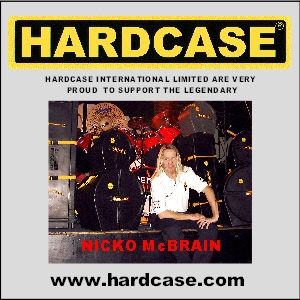 ME: Have you got any favourite snares?
ME: Have you got any favourite snares?
NMB: My Ludwig Super Sensitive, I bought it in 1975, it did all the Maiden albums up to ‘No Prayer for the Dying’ (1990). I paid 40 bucks for it, I wish I’d bought the rest of the drums, chrome finish Ludwigs! Anyway, I retired it and then I went with the bronze snare, that was absolutely wicked, what a great snare that was. Then when I changed to Premier in 1994 I went to a maple snare, I didn’t like their metal snares but I thought now I’m with Premier, I shouldn’t use my Ludwig or Sonor snares, it’s not right being a part of the new family. I thought ‘well, I’ll compromise, so I used a 5½ inch Signia snare and I fell in love with it.
It’s funny, a few months ago when we started the new record, I’d given my son my Signia kit because Premier had sent me the new professional series kit and I said; “That’s my kit now, you have my old kit”’ and I’d given it to him. But unfortunately, when I gave it to him, it had my 400 snare with it! So, I heard him playing it every day, and I had a go on it and I thought ‘this drum sounds marvellous, I’ve got to record the new album with this’. So I brought ‘the Beast’ out of retirement and I’m packing the snare and my boy says; “Oi!!” So I had to tell him; “You know this drum kit’s yours right? But it doesn’t come with this snare drum! It comes with this one!” And I gave him the brass snare and he said “OK, that’ll do!”
George from Premier came to the studio as I wanted to try out a bunch of snares, different sounds for different tracks. We ended up using the same snare, mixed differently but it was the same snare on all the songs, just with different compressions, EQ’s to get different sounds. But Premier brought me this nice 7” snare, a nice hammered finish but I didn’t really get what I wanted out it. George doesn’t know, but he will now – I took him home and gave it to my boy to get my Ludwig back!
ME: I’m finding now things for me have to change, we’re not as young as we used to be and remember Ian Paice saying he now finds different ways to achieve things as he’s getting older.
NMB: God bless Ian, he’s right. Yeah, there’s still the dynamic there. There’s technique where you can still hit and get volume out of your kit without looking like you are. I’ve found my style has come more from the wrist and the timing of the down stroke.
When we’re younger we tended not to thing of dynamics and it was about volume and ‘You turn up, you’ve got the volume control!” and that sort of attitude. This kit I’m playing, its way too big! It really is! In the studio, we did two songs and I wasn’t using the 6 and 8 inch toms and there’s two microphones sitting on the toms. We’re getting ready for the first song and said to the engineer; “I’m going to take these two drums down.” And he said, “That’s a good idea. Have got any more you can take down? Go back to a four piece!”
So we took the 6” and 8” down off the session, so therefore there are two less microphones which can make a difference. So these two drums come down because I’m really not playing them, to get up to that 6” and 8” its hard work! I’m not as quick as I used to be in turning around and moving and I’ve got a bit of extra weight. I’m an old fart, why do I want to go up there? I’ll leave the 10” and 12” and go from there. When we do ‘Trooper’, starts at the top, go down to the bottom, that one you will hear! Powerslave; start on the 6” and end up on the 18”. There are certain songs where I have got to use that part of the kit, people expect it.
ME: So we won’t see you behind a four price anytime soon?
NMB: I really do love playing a smaller 5 piece,
ME: It helps you ‘focus’ sometimes?
NMB: Yeah, we did a video during the Blaize (Bailey) era, we did it in Massala in Israel and I had this little cherry red Signia as it was all very last minute. I was in the classic set up; flat ride right next door to the one rack tom and trying to mime the song with all these toms fills! I thought I can get away with this!! Live! The girls can see me now, I’ll be quids in! Originally they stuck me behind the big kit, I’ve said it so many times and people are probably fed up with it, because I am the best looking bloke in the band.
As far as technique goes, I’m just about getting it right, the technique of how to drive with less energy spent.
ME: Efficiency of movement?
NMB: That’s an even better way of putting it. I don’t hit them as hard as I used to, I tend to do a lot of rim shots without realising it, especially on the toms, and you get that extra attack. I also tend to try and hit the drum not dead in the centre, but about an inch or so away from the centre. The more you go into the centre of the drum the more you change the character and tone, it’s a very versatile instrument, and I’m always trying to find out how many different sounds I can get out of a drum! My point is; depending on how you hit the drum, the angle of the hit, with the tip, where you hit it, off centre, rim shot, you can really change the tone. Some drummers always hit right in the middle, like Simon (Wright), especially on his snare drum,
ME: Do you think that a technique like that makes a difference so perhaps you’re not quite so knackered at the end of the gig?
NMB: That is another good point. It is primary for a player to pace yourself. When you’re a young kid, like we were once and when I was 25, 26 I was out touring with Pat Travers and others, always playing with powerful bands, great bass players, and some wonderful opportunities with outstanding bands – none more so than the guys I’m with now. So, when you’re a kid, you get out there, your first gig, the nerves are there – I still get nerves now, first song; 1-2-3-4 and you slam into it! By the end of the first song, you’re well….(feigns utter exhaustion), and you’ve got another 16 tunes to do!
You’re thinking; “When’s the next one that’s not quite as hard?” Next tune! So you’ve got a bit of breathing space, it’s a down tempo song so the idea I’ve learned over the years is I know when I look at the set that we’re going out live with; that there’s four songs that I have to give it welly on. Especially the first two, you’ve just walked out on stage and made your impression. The middle of the show normally isn’t as impressionable as the beginning and the end, there’s normally a laid back vibe, the adrenalin in the audience has gone down a bit and your mate wants to go and get a beer. Some gigs have been very intense all through, especially in Italy and South America! They’re nuts there, where do they get their energy from?
So you do get times where you can lay back a little, I don’t need to power this song, it’s more a ballady type of song and I’m there to keep time and drive. When you’ve got to drive the band, you’ve got to be at the front end and pushing it because if you don’t your going to get bollocked by the band! I have my ‘breathing’ song in the Maiden set, not to say it doesn’t get the full on 100% intensity, my attention and thought, you can’t wander off – I always try to play as if I’m playing songs for the first time.
ME: I’d like to explore the subject endorsements a little more because the difference now to say; 25 years ago when we knew that endorsements existed, we knew that people got free gear, but there was a grey area between getting free stuff and actually having to pay for it. We understood the mechanics of the endorsement process, but we also knew that we had to earn the right to be endorsed to be worth something to the endorser. Do you think there’s a risk these days that younger drummers are too focused on the quest for free gear now that there’s more talk and less mystery now in the trade press and more recently, on the internet about getting ‘free’ gear?
NMB: Exactly. In a way, I think that’s quite refreshing, because they have to understand that they are not going to get taken care unless you’re a good player, and there are levels of good players. I’m a good drummer, not a great drummer, but there’s a guy over there who’s a great drummer, it doesn’t matter. He can go out and do what he does and sell ‘X’ thousands of records a year and the other guy will go out and do what he does and they will put bums on seats and that means eyeballs and ear holes looking at and listening to your gear. You have to maintain a level of consistency and quality playing to become eligible if you like to even be considered as an endorsee.
For instance, Paiste bestowed an honour on me years ago and they made me a Paiste ambassador. Now this doesn’t mean I want all your readers bothering me for free cymbals, but I can phone Paiste up and say; “You need to give this guy a set of cymbals.” They know I wouldn’t do it just because some bloke wants free gear, it doesn’t work like that. I bought myself all my cymbals from when I started working with Iron Maiden through the deal I had via Soundhouse. But I then went to Paiste and said I need looking after now I‘ve joined Iron Maiden and they said you need to be on a No.1 deal don’t you? And I said “Yes – I need a 40” symphonic gong please!”
But I actually insisted on buying my first set of cymbals from them, as a goodwill gesture. If you’re working in a good band, with a good profile, you become talked about, lots of people get talked about and I’ve met guys with a mish mash of cymbals who want a full set of Paiste and I can help. But you have to have the passion. There are certain companies in this business that will take a drummer and give him what he wants and they don’t really care when they lose him.
ME: But there are still a significant number of drummers who just want free gear, regardless of who the supplier is.
NMB: That’s what I call whoring yourself out. It’s not about getting free gear. That will come when you establish yourself as a hot player and get a profile. When the people in the industry see potential, especially in the drumming world, they will normally try to get that person to take an interest in the product anyway. But you have to have that seriously good playing attitude and not be a prima donna.
ME: Rather like you’ve done; “I bought Remo, Paiste, whatever because I like them, I’ve paid for them, worked hard for my profile and then get the endorsement”
NMB: Yeah, exactly – but people still say to me; “Why did you go from Sonor to Premier then?” Well, Sonor was sold unfortunately and things went tits up for me with them at that time and I’d always said that if I ever changed drums I’d go with Premier. It broke my heart; I’ve always kept a soft spot for Sonor. I had some gracious offers from the big names saying the door is always open, I was leaning towards DW to be honest, I’ve always loved John Good’s way of thinking, his innovations with different woods with drums but I went to Premier and they take great care of me.
I was straight up with Tony Doughty the boss at the time, I said “Tony, you’re drums are great but your hardware sucks!” He did say I said it as I feel, but he did ask! It was at the time of the ‘Yamaha’ hardware but then they were bought out and it all went a bit ‘funny’ for a while; however the good thing is now it’s back in British hands. Which is great, I’m an Englishman, I’m in one of England’s top rock bands in the world, why not go with Premier.
ME: Any final thoughts?
NMB: The driving force for my playing is the passion. When I was young, I had a big picture of Ringo Starr in my room, with his big 15” hi hats on his Ludwig kit and he’s sat really high up, with his sunglasses on – looking out over his hi hats with a big smile on his face and you can see his stick doing that sweeping, left to right on the hats. Every night I’d go to bed, looking over my little Broadway kit with Super Zyns set up, I’d be looking at this picture and drift off. I just wanted to play that way. I loved his playing, I still do, he is so underrated, one of the top time keepers in the business and he had his own swing. He was not a technically top player; he just sat in the groove. I just got a job doing a tribute album of Beatles covers and I put myself in to do ‘A Hard Day’s Night’ just so I could do that hi hat thing!!
Interview – Mike Ellis
Dec 2006

